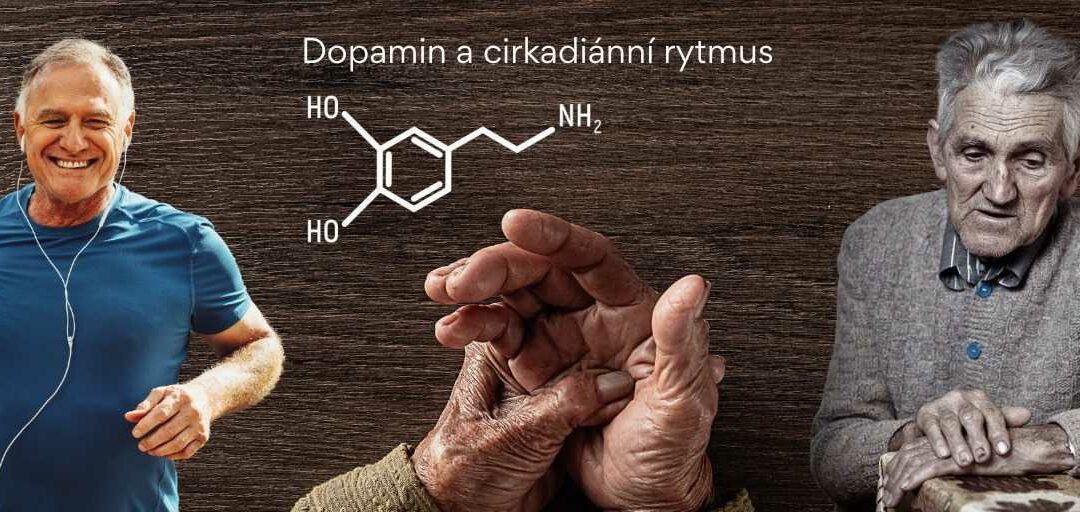Nowadays, dopamine, which belongs to the group of so-called happy hormones, is mainly associated with reward and the following experience of joy and euphoria. However, dopamine also plays an important role in other physiological processes and behaviour. It is a neurotransmitter through which neurons communicate with each other. Optimal levels of dopamine support cognitive performance, motor function, increase motivation, improve mood and control alertness (see Fig. 1). And all of these processes are also linked to circadian rhythms. In this article, you’ll read how desynchronization of circadian rhythms (CR) is linked to diseases that are linked specifically to dopamine imbalance.
Fig. 1: Dopamine is a hormone and neurotransmitter that is released mainly by nerve cells and binds to the appropriate receptors (D1, D2, D3, D4 or D5) of other cells, thus allowing the transmission of stimuli from neurons to other cells. Depending on the type of receptor and the type of cell receiving the signal, dopamine plays a role in several different physiological functions. The diagram was taken and adapted from source: 1).
Circadian rhythms are biological processes that take place in the body in a approximately 24hour cycle. And these biological processes are controlled at the molecular level by clock genes and proteins. There are a number of molecules that help maintain the proper rhythmicity of these genes, and one of them is dopamine. Its circadian activity has been demonstrated in 5 regions of the brain including the retina and hypothalamus, which includes the so-called suprachiasmatic nuclei (SCN). The SCN are the main conductor of circadian rhythms (Pacemaker), in control of the correct timing of the biological clock in all other regions.
Circadian rhythm disorders have a clinical association with mood disorders. This association between CR and behaviour can also be observed in various neurodegenerative diseases (ADHD, autism, Alzheimer’s and Parkinson’s disease). In Parkinson’s disease, for example, there is degeneration of neurons (death of brain cells), specifically the so-called dopaminergic neurons in the midbrain, which are capable of releasing dopamine, and we now know, thanks to numerous studies, that in Parkinson’s disease, in addition to motor disorders, sleep disorders, depression, anxiety, etc. are also observed.
CR is linked to dopamine regulation via two proteins (REV-ERBα and CLOCK) that are absolutely crucial in the molecular feedback loop that is the main machinery of the entire circadian rhythm. REV-ERBα inhibits the enzyme tyrosine hydroxylase, which is crucial in dopamine synthesis. Mutation of the CLOCK gene, which is a prescription for the production of the CLOCK protein, causes manic episodes through increased levels of dopamine in the midbrain. In contrast, disorders where low dopamine levels are observed, such as ADHD, have been shown to have disrupted levels of BMAL1 and PER2 proteins.
On the basis of these findings, it can be assumed that desynchronization of circadian rhythms leads to desynchronization of clock genes, and disruption of the levels of their derived proteins has been observed in disorders in which dopamine balance is also disrupted. But if we look at the inverse relationship, i.e. how dopamine affects circadian rhythms, we can take the example of the retina. This is because dopamine release in the retina allows proper adaptation to light, which is the main Zeitgeber ~ synchronizer of circadian rhythms, and the transmission of information from the external environment to the SCN. Thus, reduced levels of dopamine in the retina may impair adaptation to light, and thus disrupt circadian rhythm.
In conclusion, the relationship between dopamine and circadian rhythms appears to be bidirectional, i.e., circadian rhythms are regulated by dopamine and dopamine regulates circadian rhythms. From this point of view, it is really important to follow the basic rules of light hygiene: to expose to sufficient and good quality light during the day and, if you cannot be in the sun, at least to use electric light with a spectrum as similar to the sun as possible, and to limit light as much as possible in the evening and at night.
Mgr. Tereza Ulrichová, Spectrasol
Literature:
- Kant, M. Meena, and M. Pathania, “Dopamine: a modulator of circadian rhythms/biological clock,” International Journal of Advances in Medicine, vol. 8, p. 316, Jan. 2021, doi: 10.18203/2349-3933.ijam20210285.
- Kim, S. Jang, H. K. Choe, S. Chung, G. H. Son, and K. Kim, “Implications of Circadian Rhythm in Dopamine and Mood Regulation,” Molecules and Cells, vol. 40, no. 7, pp. 450–456, Jul. 2017, doi: 10.14348/molcells.2017.0065.
- S. Korshunov, L. J. Blakemore, and P. Q. Trombley, “Dopamine: A Modulator of Circadian Rhythms in the Central Nervous System,” Front Cell Neurosci, vol. 11, p. 91, Apr. 2017, doi: 10.3389/fncel.2017.00091.
- Bauer, D. Liu, T. Nguyen, and B. Wang, “Unraveling theInterplay of Dopamine, Carbon Monoxide, andHeme Oxygenase in Neuromodulation andCognition,” ACS Chem. Neurosci., vol. 15, no. 3, pp. 400–407, Feb. 2024, doi: 10.1021/acschemneuro.3c00742.
- M. Grippo and A. D. Güler, “Dopamine Signaling in Circadian Photoentrainment: Consequences of Desynchrony,” Yale J Biol Med, vol. 92, no. 2, pp. 271–281, Jun. 2019.


